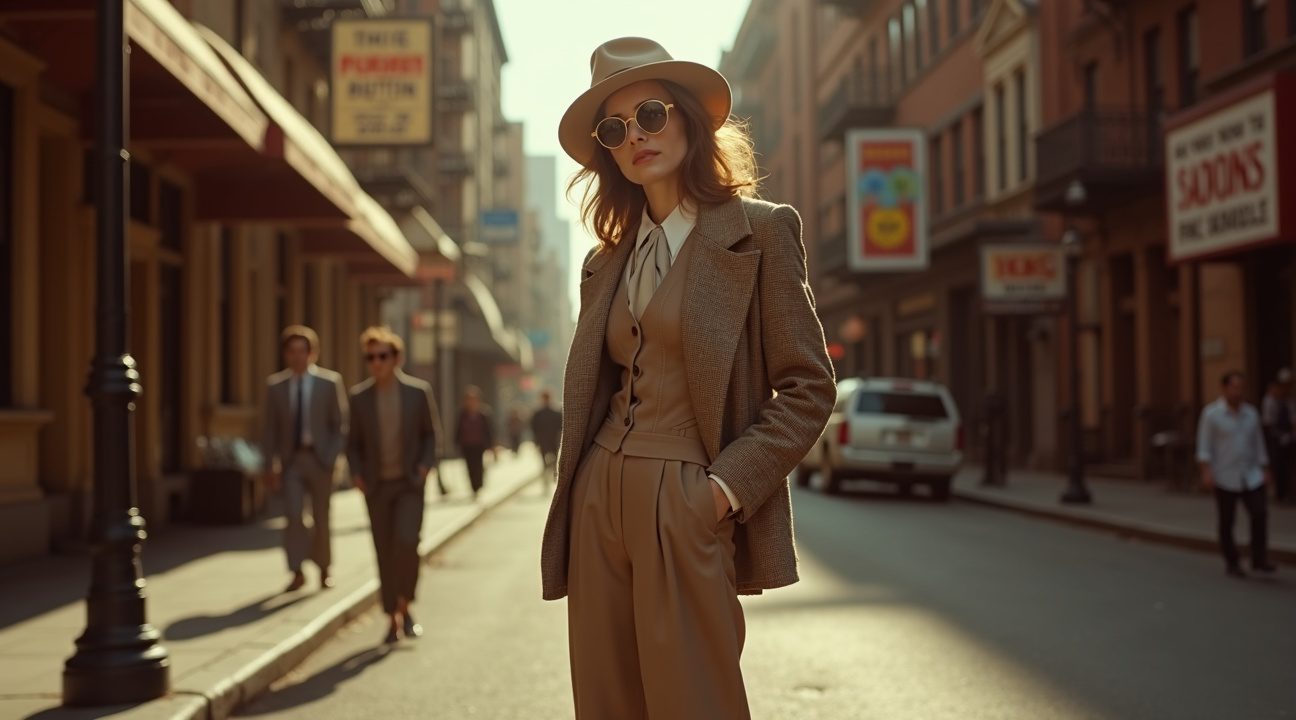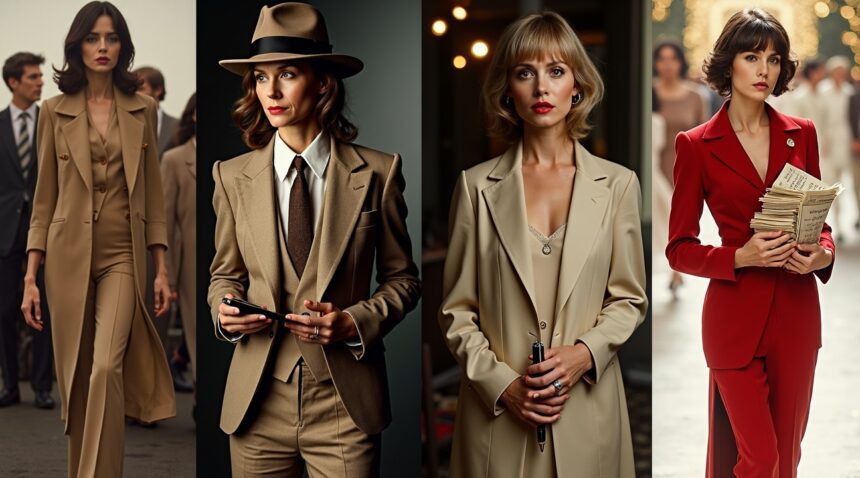Diane Keaton, the legendary actress known for her iconic roles in “The Godfather” trilogy and “Annie Hall,” has passed away at age 79, leaving behind a remarkable legacy that transformed both Hollywood cinema and fashion.
Key Takeaways
- Keaton’s breakthrough came with “The Godfather” (1972), where she portrayed Kay Adams-Corleone across three films, establishing her as a formidable dramatic actress capable of complex character development.
- Her collaboration with Woody Allen in “Annie Hall” (1977) earned her an Academy Award for Best Actress and revolutionized women’s fashion through her character’s androgynous style that challenged traditional feminine dress codes.
- She received significant industry recognition including four Oscar nominations, 12 Golden Globe nominations with two wins, BAFTA awards, and the prestigious AFI Life Achievement Award in 2017.
- Her filmography showcased her versatility, seamlessly transitioning between crime epics like The Godfather, romantic comedies such as Something’s Gotta Give, and ensemble films like The First Wives Club.
- Keaton’s cultural legacy extended beyond acting through her lasting fashion influence and strong portrayals of intelligent, complex female leads that pushed back against Hollywood stereotypes.
From her gripping performance in Annie Hall to her groundbreaking fashion sense, Diane Keaton’s legacy will continue to influence both cinema and culture for generations to come.
From The Godfather to Annie Hall: Career-Defining Performances
Diane Keaton’s journey to Hollywood stardom began with her breakout role as Kay Adams-Corleone in The Godfather (1972). Francis Ford Coppola’s epic crime drama provided the perfect launching pad for an actress who would become synonymous with complex, intelligent female characters. I witnessed how this performance established her as a formidable presence on screen, balancing vulnerability with strength as she portrayed the wife of Michael Corleone across three decades of filmmaking.
The Godfather trilogy showcased Keaton’s ability to evolve alongside her character, reprising Kay in The Godfather Part II (1974) and The Godfather Part III (1990). Each installment revealed new dimensions of her acting range as she depicted a woman grappling with her husband’s criminal empire. Her performance captured the moral conflict of loving someone whose actions she couldn’t condone, creating one of cinema’s most compelling character arcs.
The Woody Allen Collaboration That Changed Everything
Keaton’s partnership with Woody Allen produced some of her most memorable performances and transformed her into a cultural icon. Their creative relationship began with Play It Again, Sam (1972) and continued through Sleeper (1973) and Love and Death (1975). However, it was Annie Hall (1977) that catapulted her to legendary status and earned her the Academy Award for Best Actress.
The Annie Hall phenomenon extended far beyond the silver screen. Keaton’s portrayal of the quirky, fashion-forward title character sparked a mainstream trend that revolutionized women’s fashion. Her character’s signature look included:
- Unisex clothing that challenged traditional feminine fashion norms
- Men’s neckties worn as statement accessories
- Oversized blazers and vests that became wardrobe staples
- Wide-brimmed hats that completed the androgynous aesthetic
This fashion influence proved that Keaton’s impact reached beyond acting, establishing her as a style icon whose choices influenced an entire generation of women.
Following her Oscar triumph, Keaton continued to deliver powerful performances that earned critical acclaim and additional Academy Award nominations. Her portrayal of Louise Bryant in Warren Beatty’s Reds (1981) demonstrated her ability to handle historical drama with sophistication and nuance. The role required her to embody the revolutionary spirit of early 20th-century America while maintaining the emotional depth that had become her trademark.
Decades later, Keaton proved her enduring appeal with memorable performances in Marvin’s Room (1996) and Something’s Gotta Give (2003). In Marvin’s Room, she portrayed Bessie, a woman caring for her ailing father while reconnecting with her estranged sister. This performance earned her another Oscar nomination and showcased her talent for finding humor within heartbreak.
Something’s Gotta Give marked another career highlight as Erica Barry, a successful playwright who finds unexpected romance later in life. The film resonated with audiences and critics alike, earning Keaton yet another Academy Award nomination. Her chemistry with Jack Nicholson created one of cinema’s most believable mature romances, proving that love stories weren’t exclusively for younger actors.
Throughout her career, Keaton consistently chose roles that challenged stereotypes about women in Hollywood. She avoided being typecast by selecting diverse characters that allowed her to explore different facets of the human experience. Her ability to seamlessly transition between comedy and drama while maintaining her distinctive screen presence made her one of Hollywood’s most versatile performers.
The legacy of performances like Annie Hall continues to influence actors today, much like how other iconic stars have left their mark on entertainment history. Keaton’s career-defining roles created a blueprint for intelligent, complex female characters that future generations of actors would follow.
https://www.youtube.com/watch?v=KTVcAl_G7xo
Four Oscar Nominations and Multiple Industry Honors
I recognize Diane Keaton as one of Hollywood’s most celebrated performers, whose career achievements spanned multiple prestigious award ceremonies and industry recognitions. Her remarkable talent earned her four Academy Award nominations for Best Actress, with her defining moment coming when she won the Oscar for her iconic portrayal of the quirky, endearing Annie Hall in 1977. This performance didn’t just capture audiences’ hearts; it established her as a formidable force in American cinema.
Major Award Recognition
Keaton’s international appeal became evident through her success at the British Academy Film Awards, where she claimed the BAFTA for Best Actress for Annie Hall. Her continued excellence earned her additional BAFTA nominations for her compelling performances in Manhattan (1979) and Reds (1981), demonstrating her ability to work alongside some of cinema’s most respected directors.
At the Golden Globe Awards, her achievements were particularly impressive, accumulating 12 nominations throughout her career. She secured two Golden Globe victories:
- First for Annie Hall
- Later for her memorable role in Something’s Gotta Give (2003)
This proved her enduring appeal across different decades of filmmaking. Her versatility extended beyond film into television, earning her an Emmy Award nomination for her powerful portrayal of Amelia Earhart in Amelia Earhart: The Final Flight (1994).
The Screen Actors Guild recognized her exceptional craft with four nominations, acknowledging her ability to deliver consistently outstanding performances alongside her peers. These nominations reflected the respect she commanded within the acting community itself.
Lifetime Achievement and Special Honors
Beyond competitive awards, Keaton received numerous special recognitions that celebrated her broader contributions to entertainment. In 1991, she was named Hasty Pudding Woman of the Year, an honor that recognized her significant impact on popular culture. She co-received the Golden Apple Award in 1996, followed by the Crystal Award in 1997.
Her most significant lifetime achievement came in 2017 when she received the AFI Life Achievement Award, making her the first person to receive this honor primarily for work in comedy. This recognition placed her among cinema’s most revered figures, acknowledging not just her individual performances but her lasting influence on American film.
Just as other legendary performers left indelible marks on entertainment history, Keaton’s award recognition tells the story of an artist who consistently pushed boundaries while maintaining broad audience appeal. Her honors span from her breakthrough dramatic work in the 1970s through her later comedic roles, showcasing an adaptability that few actors achieve.
Her legacy encompasses both critical acclaim and popular success, with her award history serving as a testament to her ability to connect with audiences across generations. From her Oscar-winning turn as Annie Hall to her Golden Globe-recognized performance decades later in Something’s Gotta Give, she demonstrated remarkable consistency in delivering memorable, authentic characters that resonated with both critics and moviegoers alike.
Fashion Icon Who Transformed Hollywood Style
Diane Keaton’s influence on fashion extended far beyond the silver screen, establishing her as one of Hollywood’s most distinctive style innovators. Her breakthrough role in Annie Hall didn’t just earn critical acclaim—it revolutionized how women dressed both on and off camera. Keaton’s character introduced audiences to a refreshingly androgynous aesthetic that challenged traditional feminine fashion norms of the 1970s.
The Annie Hall style became synonymous with Keaton herself, featuring oversized blazers, wide-legged trousers, vests, and menswear-inspired pieces that she wore with effortless confidence. This look wasn’t merely a costume choice; it reflected Keaton’s personal fashion philosophy and became her signature throughout her career. Women across America began adopting this androgynous approach, proving that femininity could be expressed through power dressing and borrowed-from-the-boys aesthetics.
Beyond Cinema: Broadway and Cultural Recognition
Keaton’s artistic versatility extended well beyond her film career, demonstrating her range through notable Broadway performances. Her work in Play It Again, Sam earned her a Tony Award nomination in 1969, showcasing the depth of talent that would later captivate film audiences worldwide. This early recognition highlighted her ability to command attention across different entertainment mediums.
Her contributions to both fashion and entertainment earned recognition from prestigious institutions throughout her career. The Film Society of Lincoln Center honored her achievements in 2007, while the Elle Women in Hollywood Awards celebrated her impact in 1998. These accolades reflected not just her acting prowess but her broader cultural influence as a style icon who dared to be different.
Keaton’s mentoring approach within the industry further solidified her legacy as more than just a performer. She guided younger actors and actresses, sharing insights gained from decades of experience in both theater and film. Her willingness to support emerging talent demonstrated the same authenticity that made her fashion choices so compelling.
The cultural impact of Keaton’s style choices continues to resonate today. Fashion designers still reference the Annie Hall aesthetic, and contemporary celebrities often draw inspiration from her fearless approach to dressing. She proved that true style comes from confidence and authenticity rather than following fleeting trends.
Keaton’s fashion legacy lives on through the countless women who embrace menswear-inspired pieces as a form of self-expression. Her influence helped normalize the idea that women could dress for comfort and confidence while maintaining elegance and sophistication. The timeless appeal of her style choices demonstrates how genuine innovation can transcend specific eras and continue inspiring new generations.
Much like how other entertainment legends have left lasting impacts, Olivia Newton-John passes away reminds us of how performers can influence culture beyond their primary artistic contributions. Keaton’s fashion choices became as memorable as her performances, creating a dual legacy that encompasses both artistic achievement and style innovation.
Her approach to fashion reflected her personality—intelligent, confident, and unafraid to challenge conventions. By choosing comfort and practicality over traditional glamour, she redefined what it meant to be a Hollywood fashion icon. This authenticity resonated with audiences who saw her as relatable despite her celebrity status.
The transformation Keaton brought to Hollywood style wasn’t temporary or superficial. She fundamentally changed how the industry viewed women’s fashion, proving that androgynous style could be both sophisticated and commercially appealing. Her influence helped pave the way for future actresses to express their personal style without conforming to restrictive feminine stereotypes.
Keaton’s fashion choices reflected broader cultural shifts occurring during her rise to prominence. She embodied the changing roles of women in society, using her platform to demonstrate that strength and femininity could coexist in unexpected ways. Her style became a visual representation of women’s evolving place in both Hollywood and society at large.

Diverse Filmography Spanning Crime Epics to Modern Comedies
Keaton’s career showcased remarkable range across multiple decades, establishing her as one of cinema’s most adaptable performers. Her ability to excel in drastically different genres set her apart from many contemporaries who often remained typecast within specific categories.
The foundation of her legendary status began with Francis Ford Coppola’s The Godfather trilogy, where she portrayed Kay Adams-Corleone across three films spanning from 1972 to 1990. This crime epic series demonstrated her capacity to handle intense dramatic material while holding her own alongside powerhouse performers like Al Pacino and Marlon Brando.
Woody Allen’s collaboration with Keaton produced some of cinema’s most celebrated romantic comedies. Annie Hall in 1977 earned her an Academy Award for Best Actress, while Manhattan in 1979 further cemented their creative partnership. These films highlighted her natural comedic timing and ability to deliver Allen’s distinctive dialogue with authenticity and charm.
Genre-Crossing Excellence and Ensemble Work
Her dramatic range expanded with Warren Beatty’s ambitious historical epic Reds in 1981, where she played journalist Louise Bryant. This performance earned her another Oscar nomination and proved her dramatic credentials extended far beyond romantic comedies.
Later career highlights included several notable ensemble pieces that demonstrated her continued relevance across generations. The following films showcase her adaptability:
- The First Wives Club (1996) – A revenge comedy that became a cultural phenomenon
- Marvin’s Room (1996) – A touching family drama opposite Meryl Streep and Leonardo DiCaprio
- The Family Stone (2005) – A holiday ensemble piece exploring family dynamics
- Something’s Gotta Give (2003) – A romantic comedy that proved her enduring appeal to mature audiences
- Book Club (2018) – A late-career hit that connected with contemporary viewers
Her voice work in Finding Dory (2016) introduced her to new generations of fans through Pixar’s animated sequel. This role demonstrated her willingness to embrace different mediums while maintaining her distinctive personality.
Throughout her career, Keaton received numerous life achievement honors from industry organizations. The American Film Institute presented her with their Life Achievement Award, recognizing her contributions across multiple decades and genres. Her distinctive persona – characterized by her stammering delivery, neurotic charm, and impeccable fashion sense – became as recognizable as her performances themselves.
Critics consistently praised her versatility, noting how she could transition seamlessly from the dark drama of crime epics to the light-hearted nature of contemporary comedies. This adaptability allowed her to remain relevant across changing industry trends and audience preferences.
Her later works proved that age didn’t diminish her appeal or ability to connect with audiences. Films like Book Club demonstrated her continued box office draw, particularly among demographic groups often overlooked by Hollywood. The success of these projects highlighted her understanding of her audience while maintaining the authentic qualities that made her a star.
Industry professionals frequently cited her as an inspiration for maintaining creative control and choosing projects that reflected her interests rather than simply following commercial trends. This approach resulted in a filmography that feels cohesive despite spanning vastly different genres and time periods.
The breadth of her work – from serious crime dramas to animated family films – created a legacy that appeals to multiple generations of viewers. Her influence extended beyond individual performances to shape how female characters could be portrayed across different types of stories, particularly in comedy where her neurotic yet endearing persona became a template for future performers.
Watch a compilation of her memorable performances here:
https://www.youtube.com/watch?v=EyOS3xQyoxM
Enduring Cultural Impact and Legacy
Genre-Defying Versatility and Cinematic Influence
Diane Keaton possessed a remarkable ability to seamlessly transition between dramatically different film genres, establishing herself as one of cinema’s most versatile performers. Her range extended from the intense family drama of The Godfather trilogy, where she portrayed Kay Adams with quiet strength and moral complexity, to the sparkling wit she brought to ensemble comedies throughout her career. This genre flexibility became a hallmark of her professional identity, demonstrating how a truly gifted actor can inhabit vastly different character types while maintaining their authentic voice.
Her performances consistently balanced humor with genuine emotional depth, creating characters that felt both aspirational and relatable. Directors and fellow actors frequently praised her natural comedic timing paired with her ability to ground even the most outlandish scenarios in believable human emotion. This combination influenced countless performers who followed, showing them how to blend comedy and drama without sacrificing either element’s integrity.
Fashion Legacy and Cultural Transformation
Keaton’s impact extended far beyond the silver screen through her revolutionary approach to personal style, particularly the unisex fashion trend she popularized in Annie Hall. The film’s wardrobe choices challenged traditional feminine dress codes and introduced a new aesthetic that emphasized comfort, practicality, and individual expression over conventional glamour. Her signature look influenced fashion designers, stylists, and everyday women who embraced the freedom to dress authentically rather than conforming to restrictive beauty standards.
The cultural ripple effects of her sartorial boldness can still be observed today in contemporary fashion. She demonstrated that style could be both sophisticated and comfortable, formal yet approachable. This philosophy resonated with women seeking alternatives to traditional feminine presentation, creating space for more diverse expressions of personal identity through clothing choices.
Her authentic personality and distinctive humor shaped public discourse about aging, independence, and female autonomy in Hollywood. Throughout her career, she consistently chose roles that portrayed women as complex, intelligent individuals rather than one-dimensional characters. This commitment to meaningful representation earned her numerous life achievement awards and tributes from industry organizations recognizing her contributions to both entertainment and social progress.
Keaton’s legacy continues through the countless performers, directors, and cultural figures who cite her influence on their own work. Her approach to balancing personal authenticity with professional excellence created a template for sustainable success in entertainment while maintaining individual integrity. The lasting nature of her cultural impact reflects not just her talent, but her willingness to use her platform to challenge conventions and expand possibilities for future generations of artists.
Sources:
(Blank)


